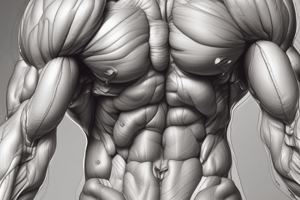Podcast
Questions and Answers
What is a key structural difference between skeletal muscle and cardiac muscle?
What is a key structural difference between skeletal muscle and cardiac muscle?
- Skeletal muscle fibers are multi-nucleated while cardiac muscle fibers have a single nucleus. (correct)
- Skeletal muscle is non-striated while cardiac muscle is striated.
- Cardiac muscle is voluntary while skeletal muscle is involuntary.
- Skeletal muscle has intercalated discs while cardiac muscle does not.
Which proteins are major components of a sarcomere?
Which proteins are major components of a sarcomere?
- Collagen and elastin
- Actin and myosin (correct)
- Hemoglobin and myoglobin
- Keratin and fibrin
What is the correct sequence of events during muscle contraction?
What is the correct sequence of events during muscle contraction?
- Calcium release, ATP hydrolysis, binding of myosin to actin. (correct)
- Calcium release, binding of myosin to actin, ATP hydrolysis.
- Binding of actin to myosin, ATP hydrolysis, calcium release.
- ATP hydrolysis, calcium release, binding of actin to myosin.
Which of the following statements about muscle cramps is true?
Which of the following statements about muscle cramps is true?
What distinguishes the origin from the attachment of muscles?
What distinguishes the origin from the attachment of muscles?
Flashcards are hidden until you start studying
Study Notes
Skeletal vs. Cardiac Muscle
- Skeletal muscle is voluntary, meaning it can be consciously controlled.
- Cardiac muscle is involuntary, meaning it cannot be consciously controlled and is found in the heart.
- Skeletal muscle has a striated appearance, meaning it has a striped pattern under a microscope.
- Cardiac muscle also has a striated appearance.
- Skeletal muscle fibers are long, cylindrical, and multinucleated.
- Cardiac muscle fibers are short, branched, and uninucleated.
Sarcomere Structure
- The sarcomere is the basic contractile unit of skeletal muscle.
- It's composed of thin filaments (actin) and thick filaments (myosin).
- Actin is a protein that forms the thin filaments.
- Myosin is a protein that forms the thick filaments.
- Myosin heads bind to actin filaments to create the power stroke that shortens the sarcomere and causes muscle contraction.
- Tropomyosin and troponin are regulatory proteins associated with actin.
- Tropomyosin blocks the myosin-binding sites on actin in a relaxed state.
- Troponin binds calcium and moves tropomyosin to expose the myosin-binding sites, initiating contraction.
Muscle Contraction Steps
- Neural Stimulation: A nerve impulse arrives at the neuromuscular junction, releasing acetylcholine (ACh) and triggering an action potential in the muscle fiber.
- Excitation-Contraction Coupling: The action potential travels along the sarcolemma and into the T-tubules, leading to the release of calcium from the sarcoplasmic reticulum.
- Cross-Bridge Formation: Calcium binds to troponin, which moves tropomyosin and exposes the myosin-binding sites on actin. Myosin heads then bind to actin, forming cross-bridges.
- Power Stroke: The myosin head pivots, pulling the actin filament towards the center of the sarcomere.
- Cross-Bridge Detachment: ATP binds to the myosin head, causing it to detach from actin.
- Relaxation: Calcium is pumped back into the sarcoplasmic reticulum, allowing tropomyosin to block the myosin-binding sites, and the muscle relaxes.
Muscle Cramps
- A muscle cramp is a painful, involuntary muscle contraction.
- Cramps can be caused by dehydration, electrolyte imbalances, overuse, or nerve compression.
- Maintaining proper hydration and electrolyte balance (especially potassium, sodium, and calcium) helps prevent cramps.
Muscle Rules
- Rule 1: All muscles have at least two attachments: An origin and an insertion.
- Rule 2: Muscles can only pull: They cannot push.
- Rule 3: Muscle action is determined by the attachment and joint crossed: The movement produced depends on where the muscle is attached and the joint it crosses.
- Rule 4: Muscles work in groups: Muscles rarely act alone.
- Rule 5: The origin is generally more proximal and the insertion is generally more distal: The origin is the fixed attachment point, while the insertion is the moving attachment point.
- Rule 6: Muscles crossing two joints can be more efficient: A muscle crossing two joints, when contracting, can have more power than a muscle crossing only one joint.
Muscle Attachment
- The origin of a muscle is the attachment point that remains stationary during movement.
- The insertion of a muscle is the attachment point that moves during contraction.
- The origin is generally more proximal (closer to the body) than the insertion.
Muscle Names
- Muscle names can be descriptive and indicate the muscle's function, shape, location, size, or number of attachments.
- Example:
- Deltoid: A triangular muscle in the shoulder region.
- Biceps brachii: Muscles with two heads and are located in the upper arm.
- Rectus abdominis: Straight muscle located in the abdomen.
Studying That Suits You
Use AI to generate personalized quizzes and flashcards to suit your learning preferences.




